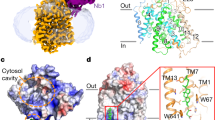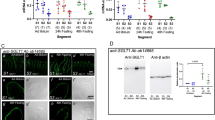Abstract
TRANSPORT of sugars and amino-acids in the small intestine occurs by apparently similar Na+-activated mechanisms which are believed to involve reversible binding of substrate to specific membrane receptors or carriers (for review, see ref. 1). At some level of the transport process, interactions between sugars and amino-acids are known to occur as indicated by reciprocal inhibitory effects2–10. Various hypotheses have been advanced to explain these findings, but the observations from several different laboratories—taken collectively—seem contradictory to the point of making each of these hypotheses untenable. The purpose of this communication is to re-examine the problem in the light of some new observations with hamster intestine and, using this information, to ascertain whether the lack of agreement between various laboratories may simply be a result of a failure to take into consideration the existence of significant differences between species.
This is a preview of subscription content, access via your institution
Access options
Subscribe to this journal
Receive 51 print issues and online access
$199.00 per year
only $3.90 per issue
Buy this article
- Purchase on Springer Link
- Instant access to full article PDF
Prices may be subject to local taxes which are calculated during checkout
Similar content being viewed by others
References
Crane, R. K., in Intracellular Transport (edit. by Warren, K. B.), 71 (Academic Press, New York, 1966).
Cori, C. F., Proc. Soc. Exp. Biol. and Med., 24, 125 (1926).
Cividanes, I., Larralde, J., and Bello, J., Rev. Espan. Fisiol., 20, 11 (1964).
Newey, H., and Smyth, D. H., Nature, 202, 400 (1964).
Saunders, S. J., and Isselbacher, K. J., Biochim. Biophys. Acta, 102, 39 (1965).
Alvarado, F., Science, 151, 1010 (1966).
Annegers, J. H., Amer. J. Physiol., 210, 701 (1966).
Chez, R. A., Schultz, S. G., and Curran, P. F., Science, 153, 1012 (1966).
Hindmarsh, J. T., Kilby, D., and Wiseman, G., J. Physiol., 186, 166 (1966).
Read, C. P., Biol. Bull., 133, 630 (1967).
Alvarado, F., and Crane, R. K., Biochim. Biophys. Acta, 93, 116 (1964).
Crane, R. K., and Wilson, T. H., J. Appl. Physiol., 12, 145 (1958).
Semenza, G., in XV Annual Colloquium on Protides of the Biological Fluids (edit. by Peeters, H.) (Elsevier Publishing Co., Amsterdam, in the press).
Bingham, J. K., Newey, H., and Smyth, D. H., Biochim. Biophys. Acta, 130, 281 (1966).
Munck, B. G., Biochim. Biophys. Acta, 156, 192 (1968).
Author information
Authors and Affiliations
Rights and permissions
About this article
Cite this article
ALVARADO, F. Amino-acid Transport in Hamster Small Intestine: Site of Inhibition by D-Galactose. Nature 219, 276–277 (1968). https://doi.org/10.1038/219276a0
Received:
Published:
Issue Date:
DOI: https://doi.org/10.1038/219276a0
This article is cited by
-
Molecular weight of a D-glucose and L-histidine-binding protein from intestinal brush borders
Nature (1974)
-
Characteristics of amino acid accumulation by isolated intestinal epithelial cells
The Journal of Membrane Biology (1973)
-
Interaction between the sugar and amino-acid transport systems at the small intestinal brush border: A comparative study
Pfl�gers Archiv European Journal of Physiology (1971)
Comments
By submitting a comment you agree to abide by our Terms and Community Guidelines. If you find something abusive or that does not comply with our terms or guidelines please flag it as inappropriate.



